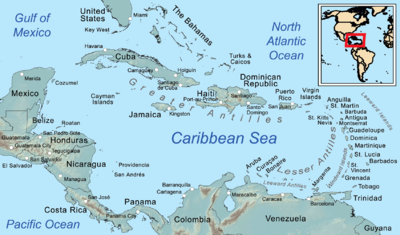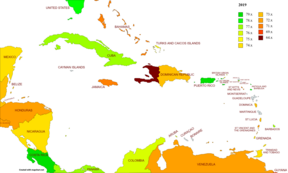West Indies
| Religions |
|
|---|---|
| Demonym | West Indian, Caribbean |
| Countries | |
| Dependencies | 18
|
| Languages | |
| Time zones | UTC−05:00 to UTC−04:00 |
| Internet TLD | Multiple |
| Calling code | Multiple |
| Largest cities | List of metropolitan areas in the Caribbean Santo Domingo Havana Port-au-Prince San Juan Kingston Santiago de Cuba Santiago de los Caballeros Nassau Camagüey Cap-Haïtien |
| UN M49 code | 029 – Caribbean419 – Latin America019 – Americas001 – World |

The West Indies is a subregion of North America, surrounded by the North Atlantic Ocean and the Caribbean Sea, which comprises 13 independent island countries and 19 dependencies in three archipelagos: the Greater Antilles, the Lesser Antilles, and the Lucayan Archipelago.[5]
The subregion includes all the islands in the Antilles, plus The Bahamas and the Turks and Caicos Islands, which are in the North Atlantic Ocean. Nowadays, the term West Indies is often interchangeable with the term Caribbean, although the latter may also include some Central and South American mainland nations which have Caribbean coastlines or coastlines close to the Caribbean, such as Belize, French Guiana, Guyana, and Suriname, as well as the Atlantic island nation of Bermuda, all of which are geographically distinct from the three main island groups, but culturally related.
Origin and use of the term
In 1492, Christopher Columbus became the first European to record his arrival at the islands, where he is believed by historians to have first set foot on land in The Bahamas. After the first of the voyages of Christopher Columbus to the Americas, Europeans began to use the term West Indies to distinguish this region from both the original "Indies" (i.e. India) and the East Indies of South Asia and Southeast Asia.[6][7][8]
History
Many cultures were indigenous to these islands, with evidence dating some of them back to the mid-6th millennium BCE.
In the late sixteenth century, French, English and Dutch merchants and privateers began operations in the
The struggle between the northern Europeans and the Spanish spread southward in the mid to late seventeenth century, as English, Dutch, French and Spanish colonists, and in many cases, enslaved Africans first entered and then occupied the coast of The Guianas (which fell to the French, English and Dutch) and the Orinoco valley, which fell to the Spanish. The Dutch, allied with the Caribs of the Orinoco, would eventually carry the struggles deep into South America, first along the Orinoco and then along the northern reaches of the Amazon.

Since no European country had occupied much of Central America, gradually, the English of Jamaica established alliances with the
From the 17th through the 19th century, the European colonial territories of the West Indies were the French West Indies, British West Indies, the Danish West Indies, the Netherlands Antilles (Dutch West Indies), and the Spanish West Indies.
In 1916, Denmark sold the Danish West Indies to the United States[9] for US$25 million in gold, per the Treaty of the Danish West Indies. The Danish West Indies became an insular area of the U.S., called the United States Virgin Islands.
Between 1958 and 1962, the United Kingdom re-organised all their West Indies island territories (except the British Virgin Islands and the Bahamas) into the West Indies Federation. They hoped that the Federation would coalesce into a single, independent nation. However, the Federation had limited powers, numerous practical problems, and a lack of popular support; consequently, it was dissolved by the British in 1963, with nine provinces eventually becoming independent sovereign states and four becoming current British Overseas Territories.
"West Indies" or "West India" was a part of the names of several companies of the 17th and 18th centuries, including the Danish West India Company, the Dutch West India Company, the French West India Company, and the Swedish West India Company.[10]
West Indian is the official term used by the U.S. government to refer to people of the West Indies.[11]
The term survives today mainly through the West Indies cricket team, representing all of the nations in the West Indian islands.
Geology


The West Indies are a geologically complex island system consisting of 7,000 islands and islets stretching over 3,000 km (2000 miles) from the Florida peninsula of North America south-southeast to the northern coast of Venezuela.[12] These islands include active volcanoes, low-lying atolls, raised limestone islands, and large fragments of continental crust containing tall mountains and insular rivers.[13] Each of the three archipelagos of the West Indies has a unique origin and geologic composition.
Greater Antilles
The Greater Antilles is geologically the oldest of the three archipelagos and includes both the largest islands (Cuba, Jamaica, Hispaniola, and Puerto Rico) and the tallest mountains (Pico Duarte, Blue Mountain, Pic la Selle, Pico Turquino) in the Caribbean.[14] The islands of the Greater Antilles are composed of strata of different geological ages including Precambrian fragmented remains of the North American Plate (older than 539 million years), Jurassic aged limestone (201.3-145 million years ago), as well as island arc deposits and oceanic crust from the Cretaceous (145-66 million years ago).[15]
The Greater Antilles originated near the Isthmian region of present day Central America in the Late Cretaceous (commonly referred to as the Proto-Antilles), then drifted eastward arriving in their current location when colliding with the Bahama Platform of the North American Plate ca. 56 million years ago in the late Paleocene.[16] This collision caused subduction and volcanism in the Proto-Antillean area and likely resulted in continental uplift of the Bahama Platform and changes in sea level.[17] The Greater Antilles have continuously been exposed since the start of the Paleocene or at least since the Middle Eocene (66-40 million years ago), but which areas were above sea level throughout the history of the islands remains unresolved.[18][16]
The oldest rocks in the Greater Antilles are located in Cuba. They consist of
Lesser Antilles
The Lesser Antilles is a volcanic island arc rising along the leading edge of the Caribbean Plate due to the subduction of the Atlantic seafloor of the North American and South American plates. Major islands of the Lesser Antilles likely emerged less than 20 Ma, during the Miocene.[14] The volcanic activity that formed these islands began in the Paleogene, after a period of volcanism in the Greater Antilles ended, and continues today.[22] The main arc of the Lesser Antilles runs north from the coast of Venezuela to the Anegada Passage, a strait separating them from the Greater Antilles, and includes 19 active volcanoes.[23]
Lucayan Archipelago
The Lucayan Archipelago includes The Bahamas and the Turks and Caicos Islands, a chain of barrier reefs and low islands atop the Bahama Platform. The Bahama Platform is a carbonate block formed of marine sediments and fixed to the North American Plate.[13] The emergent islands of the Bahamas and Turks and Caicos likely formed from accumulated deposits of wind-blown sediments during Pleistocene glacial periods of lower sea level.[13]
Countries and territories by subregion and archipelago

Caribbean (core area)
Antilles
Greater Antilles
 Cayman Islands (United Kingdom)
Cayman Islands (United Kingdom) Cuba
Cuba Jamaica
Jamaica Navassa Island (United States)
Navassa Island (United States) Puerto Rico (United States)
Puerto Rico (United States)- Hispaniola
Lesser Antilles
Leeward Antilles
Leeward Islands
 Anguilla (United Kingdom)
Anguilla (United Kingdom) Antigua and Barbuda
Antigua and Barbuda Guadeloupe (France)
Guadeloupe (France)
 Montserrat (United Kingdom)
Montserrat (United Kingdom) Saint Barthélemy (France)
Saint Barthélemy (France) Saint Kitts and Nevis
Saint Kitts and Nevis Saint Martin (France)
Saint Martin (France) SSS islands
SSS islands
- Virgin Islands
Windward Islands
Isolated islands in the Lesser Antilles
Lucayan Archipelago
Isolated island in the Caribbean
Central America
 Belize
Belize Costa Rica
Costa Rica Guatemala
Guatemala Honduras
Honduras Nicaragua
Nicaragua Panama
Panama Quintana Roo (Mexico^)
Quintana Roo (Mexico^) San Andrés and Providencia (Colombia)
San Andrés and Providencia (Colombia)
 Yucatán (Mexico^)
Yucatán (Mexico^)
Northern America
South America
N.B.: Territories in italics are parts of transregional sovereign states or non-sovereign dependencies.
* These three Dutch Caribbean territories form the BES islands.
† Physiographically, these are continental islands not part of the volcanic Windward Islands arc. However, based on proximity, these islands are sometimes grouped with the Windward Islands culturally and politically.
~ Disputed territories administered by Colombia.
^ The United Nations geoscheme includes Mexico in Central America.[24]
# Physiographically, Bermuda is an isolated oceanic island in the North Atlantic Ocean, not a part of the Caribbean, West Indies, North American continent or South American continent. Usually grouped with Northern American countries based on proximity; sometimes grouped with the West Indies culturally.
See also
- Caribbean Basin Initiative
- Caribbean Basin Trade Partnership Act
- Caribbean Community
- History of the British West Indies
- Spanish colonization of the Americas
References
- ^ "World Population Prospects 2022". United Nations Department of Economic and Social Affairs, Population Division. Retrieved July 17, 2022.
- ^ "World Population Prospects 2022: Demographic indicators by region, subregion and country, annually for 1950-2100" (XSLX) ("Total Population, as of 1 July (thousands)"). United Nations Department of Economic and Social Affairs, Population Division. Retrieved July 17, 2022.
- ISBN 978-0-19-516670-5.
- .
- Frank Cass and Co. p. 11. Retrieved 12 December 2013.
- ^ "History of the Caribbean (West Indies)". www.historyworld.net.
- ^ "west+indies | Origin and meaning of phrase west+indies". Online Etymology Dictionary.
- ^ "East Indies". Encyclopedia.com.
- ^ "Two telegrams about the sale – The Danish West-Indies". The Danish West-Indies. Retrieved 13 October 2017.
- ISBN 9780199862719.
- ^ "Info Please U.S. Social Statistics". Retrieved 1 October 2015.
- ^ "West Indies | History, Maps, Facts, & Geography". Encyclopedia Britannica. Retrieved 12 March 2019.
- ^ PMID 17446164.
- ^ OCLC 46240352.
- ^ "Flora of the West Indies / Department of Botany, National Museum of Natural History, Smithsonian Institution". naturalhistory2.si.edu. Retrieved 14 April 2019.
- ^ JSTOR 3094007.)
{{cite journal}}: CS1 maint: DOI inactive as of January 2024 (link - S2CID 16369341. Archived from the original(PDF) on 17 June 2020.
- S2CID 55392113.
- ISBN 978-0813711294
- ^ a b geolounge (8 January 2012). "Caribbean Islands: the Greater Antilles". GeoLounge: All Things Geography. Retrieved 14 April 2019.
- ^ ISBN 978-0813722627
- JSTOR 4135610.
- ^ "The University of the West Indies Seismic Research Centre". uwiseismic.com. Archived from the original on 30 March 2019. Retrieved 14 April 2019.
- ^ "UNSD Methodology – Standard country or area codes for statistical use (M49)". Archived from the original on 2017-08-30. Retrieved 2020-05-04.
Further reading
- Cave, Roderick, and R. Cave. 1978. "Early Printing and the Book Trade in the West Indies". Library Quarterly 48 (April): 163–92.
- Cromwell, Jesse. "More than Slaves and Sugar: Recent Historiography of the Trans-imperial Caribbean and Its Sinew Populations". History Compass (2014) 12#10 pp 770–783.
- Higman, Barry W. A Concise History of the Caribbean. (2011)
- Jones, Alfred Lewis (1905). . The Empire and the century. London: John Murray. pp. 877–882.
- Martin, Tony, Caribbean History: From Pre-colonial Origins to the Present (2011)


